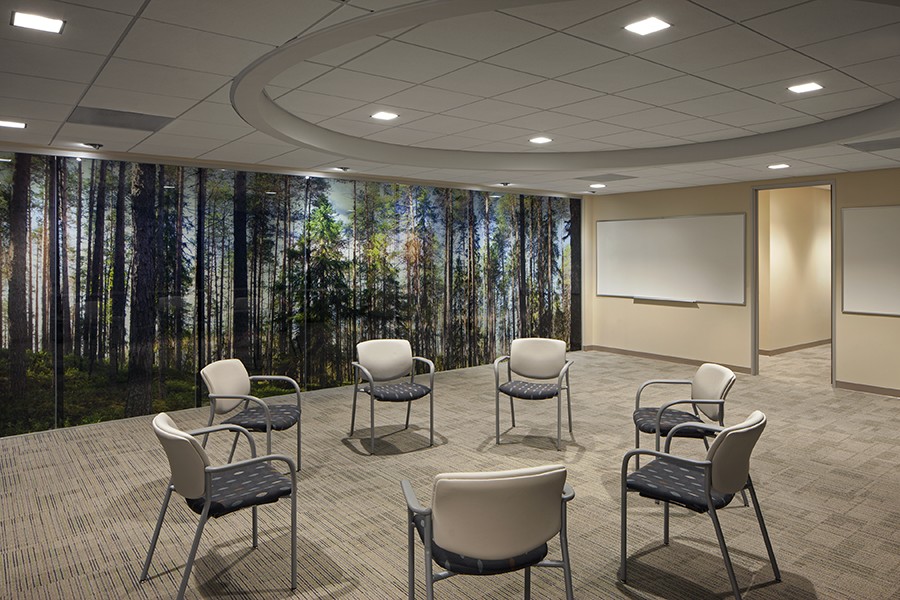With passage of the healthcare law providing increased coverage for behavioral health services, treatment services for substance use disorders are being integrated with general healthcare. Many healthcare organizations are including spaces for outpatient behavioral health within primary care clinics, and the growing public awareness of addiction as a disease is helping to lessen the associated stigma of getting treatment. However, the need for privacy and discretion, for both legal and clinical reasons, remains integral to a patient’s experience as more outpatient facilities open within multi-tenant buildings, often in highly visible, urban areas. As such, several key design elements can help protect privacy.
Entrances and Exits: Balancing Hospitality with Privacy
Patients seeking treatment enter a facility needing not only a welcoming environment, but also a space that allows them to maintain anonymity within the clinic. Behavioral health patients have often gone through short-term residential treatment and are moving into transitional care consisting of one-on-one counseling, group therapy or education, family support and continuing care. The front desk is their first point of contact. The receptionist needs to serve as both concierge and gatekeeper, welcoming patients and maintaining the barrier to confidential information, visitors and situations within. Everything behind the receptionist must be protected and secured—visually and physically. The design of the desk needs to allow the receptionist to greet people while concealing computer screens and paperwork from those checking in. In this, as in all work spaces throughout the clinic, printers, phones, computers and filing cabinets should be located away from general traffic areas to avoid potentially exposing confidential information.
Some clinics are incorporating trends used in the hospitality industry, allowing first-time patients to register at the main desk while directing others to kiosks or computer stations where they can quietly check in and not interrupt the flow of new visitors. This allows individualized and efficient registration.
Building entrances are an important point of entry. Security is required to maintain the well-being of patients and staff, but privacy is often equally important.
Many visitors arrive by car via an underground parking garage or surface lot. A dedicated entrance to the clinic with direct access to the office can safeguard privacy. When possible, designing a secondary “back door” as an alternative entrance also gives patients an option to come and go without being seen.
Acoustics
Group, family and individual therapies are an integral part of behavioral healthcare. Discussions can get loud. Therefore, acoustic privacy is critical to any clinical setting. It is important to minimize sound leakage into the hallway where a passerby can overhear conversations inside a room. Sound masking, noise blankets between rooms, sound-absorbing doors, ambient music and other techniques can promote acoustical privacy. Some clinical spaces are flexible to allow for group or one-on-one activities and need general acoustic treatments but others require specific techniques because of specific programming. Private phone rooms or pods can be integrated to allow patients to log onto a personal account or check their phone messages.
A Case Study in Design for Privacy
The recently completed Betty Ford Center Outpatient Clinic in Los Angeles, California, part of the Hazelden Betty Ford Foundation, is a good example of what many rehabilitation organizations are doing to expand outpatient services for substance addiction. This project was a catalyst to implement the new brand of Hazelden Betty Ford Foundation. It takes into account the design legacy of the Betty Ford Center in Rancho Mirage in addition to the legacy of Hazelden, keeping the design appropriate for the Los Angeles market. Even though privacy is important, building signage was implemented to give exposure to the Betty Ford Center brand with the entrance into a new market.
Located within a widely trafficked, multi-tenant office building in West Los Angeles, the state-of-the-art facility includes a centrally located reception and waiting area that allows direct navigation to multiple areas of the clinic. A pocket door behind the reception desk hides additional workspace, away from public view. Down the hall from the reception area is a large gathering space that flexes into a training or conference room, which visitors and staff can also access through a second entrance.
The floor plan includes a break-out room for staff and patients to relax, three small group classrooms, an observation room and eight offices (including one intake office and two flex offices). The space was designed for staff and patients to be able to have informal conversations around the group rooms by providing bench alcoves in the corridor and smaller rooms that can act as pre-function rooms. These spaces can also be used as individual reflection areas. The break-out room is designed to be a café or gathering place for patients to find support in their social community. Private offices for the staff are clustered together, away from the gathering spaces. The comfortable design maximizes natural light in the treatment spaces and the environment is aesthetically enhanced by built-in vignette boxes and rough-hewn wood accents. The design respects patient privacy through carefully crafted entryways and access to treatment rooms.
More healthcare organizations are thinking holistically about patients’ access to all services. As a result, they are adding outpatient behavioral treatment—an area of care in which the need for discretion is often essential to a patient’s experience and a clinic’s professionalism. By keeping privacy as a priority in the design process, healthcare organizations can deliver more effective and superior care.
Photos courtesy of Tom Bonner.





